Lake Shawl
06.Feb.18 / Kirsten BalleringThe lake shawl is inspired by pictures of beautiful sunsets on the great lakes of the world! The motif creates a star shape and triangles when joined in the corners. The shawl is approximately 170cm (67in) wide and 60cm (22in) high after blocking. The crochet pattern is suitable for all skill levels and is written in UK terms. On the left you see the Stone Washed version, and on the right you see the River Washed version. Special thanks go out to my testers Anci and Marieke, who tested the pattern thoroughly!
Materials and preparation
Yarn
Stone Washed version
Scheepjes Stone Washed (78% cotton, 22% acrylic, 50g/130m)- Colour A: 821 Pink Quartzit x 2 balls
- Colour B: 813 Amazonite x 1 ball
- Colour C: 815 Green Agate x 1 ball
- Colour D: 808 Corundum Ruby x 1 ball
- Colour E: 805 Blue Apatite x 1 ball
- Colour F: 802 Smokey Quartz x 1 ball

Stone Washed and River Washed Version
Scheepjes Stone Washed (78% cotton, 22% acrylic, 50g/130m)- Colour A: 821 Pink Quartzite x 2 balls

- Colour B: 944 Nile x 1 ball
- Colour C: 946 Mississippi x 1 ball
- Colour D: 943 Mekong x 1 ball
- Colour E: 942 Steenbras x 1 ball
- Colour F: 945 Ganges x 1 ball
Shop the yarn
You can find this yarn via Scheepjes retailers such as:
Crochet hook
4.0mm (US G/6).
Measurements
The shawl measures 170cm (67in) in length and 60cm (22in) in width after blocking.
Gauge/tension
One finished and blocked motif measures 10cm (4in) in diameter using a 4.0mm hook.
Notes
- Colours B through to F are referred to as contrast colour.
- Make 68 motifs: 13 motifs each in Colour B and C, and 14 motifs each in Colour D, E and F.
- The shawl uses the join-as-you-go method. Start with the motif in the bottom point, and work up row by row. The most left motifs of each row are made after the row is complete. For clarification, see the colour placement diagram.
Abbreviations (US terms)
- beg-ch: beginning chain
- ch: chain
- ch sp(s): chain space(s)
- dc: double crochet
- ss: slip stitch
- tr2tog: treble 2 stitches together (*yarn over, draw up loop, yarn over, pull through first 2 loops on hook; repeat from * once more, yarn over, pull through all loops on hook)
- tr3tog: treble 3 stitches together (*yarn over, draw up loop, yarn over, pull through first 2 loops on hook; repeat from * 2 twice more, yarn over, pull through all loops on hook)
Repeat formats
- *….; rep from * once/twice/3x Crochet the instructions after * and then repeat that section a further number of times as indicated.
- (…) once/twice/3x Crochet the instructions between brackets the total number of times indicated.
- […] Indicates the amount of stitches at the end of a row or round.
Colour layout
Colour Placement Stone Washed version
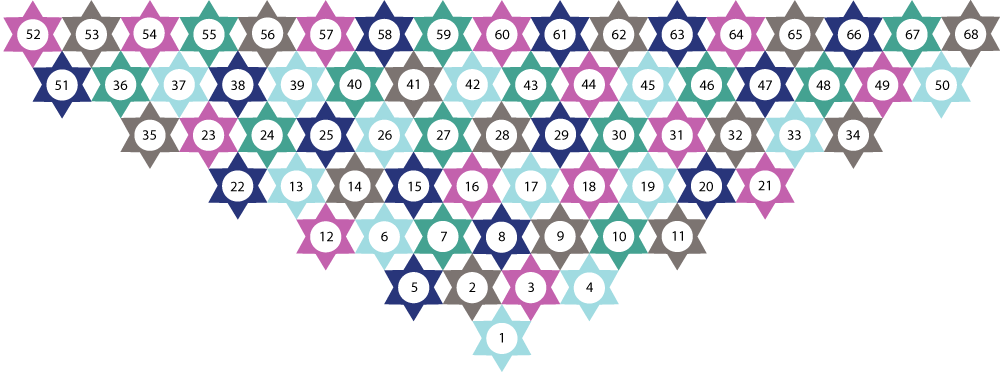
Colour Placement River Washed version
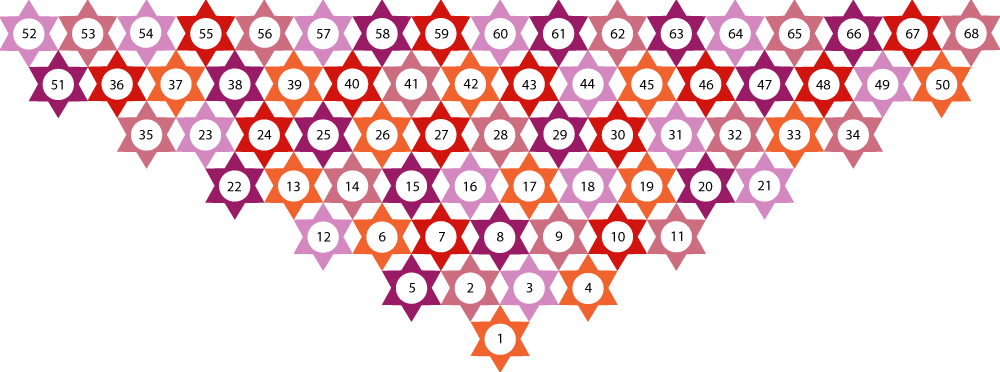
* The numbers in the stars represent the order in which they are joined. Start with 1 on the bottom of the triangle shape. Next, join 2, 3, 4, 5 and so on. Pay special attention to where star 5, 12, 22 etc. is located (i.e. most left star in a row).
And here is the colour placement chart again, if you prefer tables:

Crochet pattern
Single Motif
With Colour A, make a magic ring.
Round 1 Ch3, tr2tog (counts as first tr3tog), ch3, (tr3tog, ch3) 5 times, ss in 3rd ch of beg-ch. Fasten off. [6 tr3tog-clusters, 6 ch3-sps]
Round 2 Join Contrast Colour in ch3-sp with ss, (ch3, tr2tog (counts as first tr3tog), ch1, tr3tog) in ch3-sp, ch6, ss in 3rd ch of 6 ch, ch3, *(tr3tog, ch1, tr3tog) in ch3-sp, ch6, ss in 3rd ch of 6 ch, ch3; repeat from * 4 times more, join with ss in 3rd ch of beg-ch. Fasten off. [6 tr3tog-clusters, 6 ch-sps]
Joining
Repeat motif pattern for all next motifs. The colours are distributed semi-random. For guidance, see the colour placement diagram below. Join motifs in rows from left to right, but keep in mind that the most left motif in a row is joined last, because otherwise there won’t be any ch3-sps to join to. For clarification, see the number sequence in the colour placement diagram.
You are joining your motifs in the ch3-sps that are made in each corner. To join, follow the instructions for Round 2 of the motif. Whenever you reach a corner that needs to be joined to another corner replace ‘ch6, ss in 3rd ch of 6ch’ with ‘ch4, ss in ch3-sp of adjacent motif(s), ch2, ss in 2nd ch from hook’ to form a join to other motifs and create the ch3-sp in the motif you’re working on. This might look tedious at first but will become easier once you continue your shawl. For joining points, see the border diagram. Join ss are represented as big dots between motifs corners.
Edging
Long side Starting in top-right ch3-corner of shawl, join Colour A with ss, (1dc, ch3, 1dc) in ch3-corner, ch4, 1dc in tr3tog-sp, ch4, (1dc, ch3, 1dc) in ch3-sp, ch4, 1dc in tr3tog-sp, ch4, 1dc in ch3-corner of motif, ch3, 1dc in ch3-corner of next motif, *ch4, 1dc in tr3tog-sp, ch4, (1dc, ch3, 1dc) in ch3-sp, ch4, 1dc in tr3tog-sp, ch4, 1dc in ch3-corner of motif, ch3, 1dc in ch3-corner of next motif; repeat from * 14 times more, ch4, 1dc in tr3tog-sp, ch4, (1dc, ch3, 1dc) in ch3-sp, ch4, 1dc in tr3tog-sp, ch4, (1dc, ch3, 1dc) in ch3-corner. Continue with left short side.
Left short side Ch4, 1dc in tr3tog-sp, ch4, (1dc, ch3, 1dc) in ch3-sp, ch4, 1dc in tr3tog-sp, ch4, 1dc in ch3-corner of motif, ch3, 1dc in ch3-corner of next motif, *ch4, 1dc in tr3tog-sp, ch4, (1dc, ch3, 1dc) in ch3-sp, ch4, 1dc in tr3tog-sp, ch4, (1dc, ch3, 1dc) in ch3-sp, ch4, 1dc in tr3tog-sp, ch4, 1dc in ch3-corner of motif, ch3, 1dc in ch3-corner of next motif, ch4, 1dc in tr3tog-sp, ch4, 1dc in ch3-corner of motif, ch3, 1dc in ch3-corner of next motif; repeat from * 4 times more, ch4, 1dc in tr3tog-sp, ch4, (1dc, ch3, 1dc) in ch3-sp, ch4, 1dc in tr3tog-sp, ch4, (1dc, ch3, 1dc) in ch3-sp (bottom of shawl reached). Continue with right short side.
Right short side Ch4, 1dc in tr3tog-sp, ch4, (1dc, ch3, 1dc) in ch3-sp, ch4, 1dc in tr3tog-sp, ch4, 1dc in ch3-corner of motif, ch3, 1dc in ch3-corner of next motif, *ch4, 1dc in tr3tog-sp, ch4, 1dc in ch3-corner of motif, ch3, 1dc in ch3-corner of next motif, ch4, 1dc in tr3tog-sp, ch4, (1dc, ch3, 1dc) in ch3-sp, ch4, 1dc in tr3tog-sp, ch4, (1dc, ch3, 1dc) in ch3-sp, ch4, 1dc in tr3tog-sp, ch4, 1dc in ch3-corner of motif, ch3, 1dc in ch3-corner of next motif; repeat from * 4 times more, ch4, 1dc in tr3tog-sp, ch4, (1dc, ch3, 1dc) in ch3-corner, ch4, 1dc in tr3tog-sp, ch4, join with ss in first dc.
Fasten off. Weave in all ends and block to size.
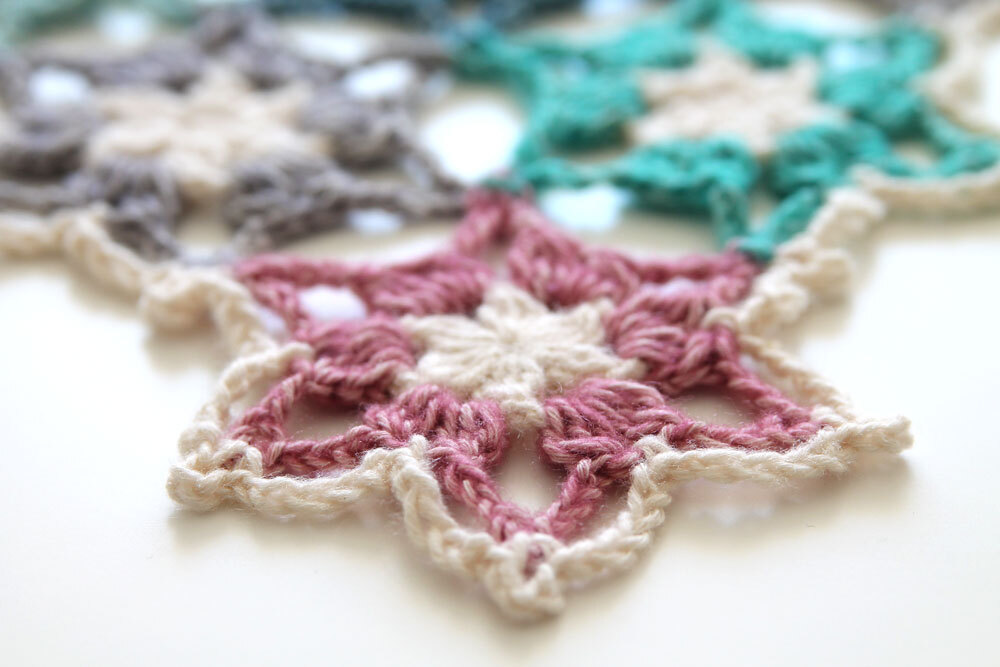
Diagram
Single Motif
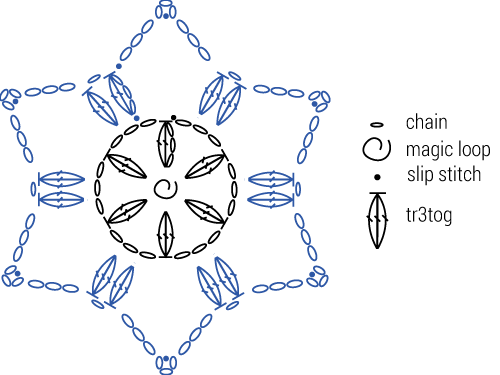
Edging diagram
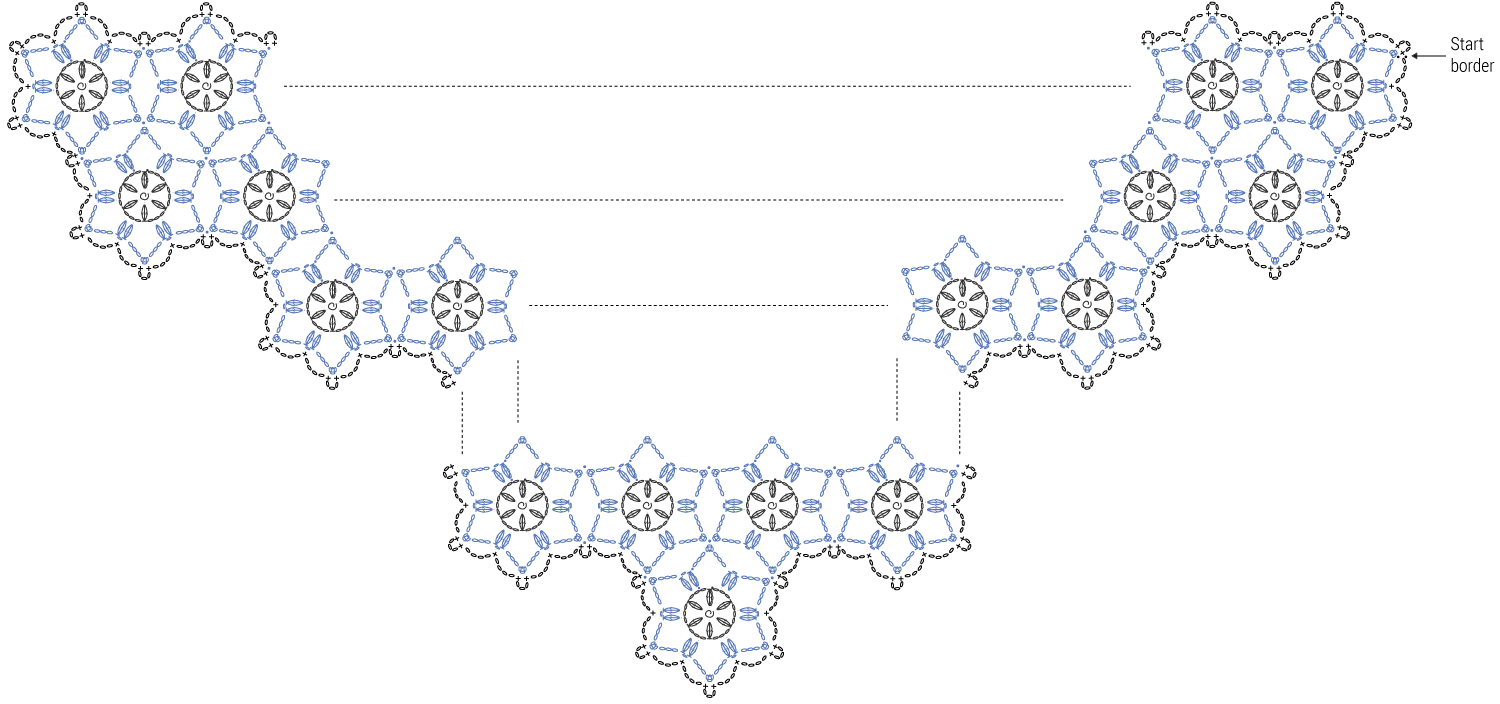




Comments
Be the first to comment to this post!